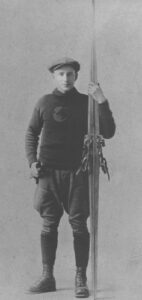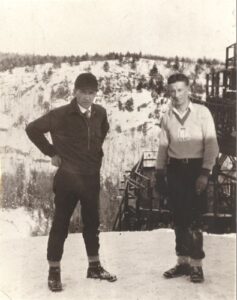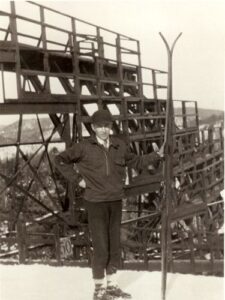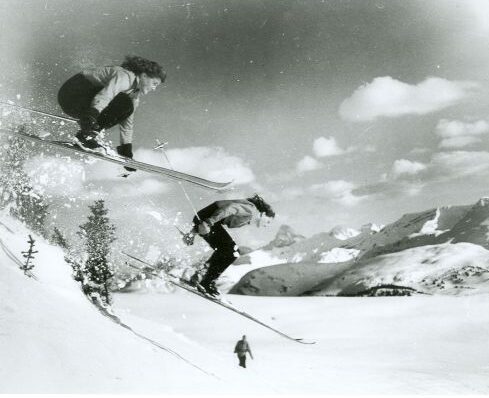Hall of Famer
Nils Johan (Nels) Nelsen
Although Nels Nelsen is remembered primarily for his daring and skill as a champion ski jumper, his contribution to the development of the sport of skiing in Western Canada was perhaps even more impressive.
Born in Norway in 1894, he arrived in Revelstoke, British Columbia as an immigrant in 1912. Within two years of his arrival, he had established himself as a driving force in the local skiing community, organizing its first winter carnival and ski tournament in 1915 on a small hill on the lower slopes of Mount Revelstoke, located in the Mount Revelstoke National Park. The Revelstoke Ski Club, one of the oldest in Canada, also reorganized in the same year largely as a result of his efforts. A larger hill, variously known as the “Big Hill” or “Suicide Hill” was created that year and was later re-named in his memory.
On February 13th, 1919, the Revelstoke Review reported that: “The Canadian skijumping championship was again landed by Nels Nelsen yesterday for the third time in succession with a largely increased lead for (sic) his former record. With ideal conditions existing on the hill, and in the presence of two thousand people, he made the phenomenal jump of 170 feet, also capturing the prize for form.” It was only one of many victories.
By the early 1920s, Nels Nelsen was already a legend, well-known throughout Canada for his skiing exploits. In February 1925, his reputation was further enhanced when he broke the existing world’s longest jump record with a leap of 224 feet (73.125 metres), which he later extended to 240 feet, a feat which caught the attention of the Europeans. The Europeans, however, never officially accepted Nelsen’s jump as a “world” record since, “… we do not approve of such “records” being unduly stressed, since it is more than possible for a man to cover a shorter distance on, say, Holmenkollen and make a finer jump than another man who covers a greater distance, but without the same degree of skill, on a jumping hill built on a larger scale.” (Extracted from The Annual Publication of the British Ski Jumping Club 1930, edited by Alexander Keiller.)
Nevertheless, from the viewpoint of distance alone, no European, or any other ski jumper for that matter, had leaped such a great distance until the Swiss Olympic jumper, Adolf Badrutt, managed the feat three years later, in 1928, with a jump of 75 metres or 246 feet. In an era when ski jumping was an organized and popular professional sport in the USA where famous jumpers were, bought, sold and traded, and large cash prizes offered, Nels Nelsen steadfastly declined to compete for money and remained an amateur.
When he did enter events in the US, competing against professionals, he invariably did well, placing among the top jumpers. Almost as well known in the US as in Canada, he was proposed by well-known ski jumping contemporaries and Hall of Fame inductees, Sig Steinwaal, Ragnar Omtvedt and Harry Lien for Honored Membership in the United States National Ski Hall of Fame.
Not nearly as well known was his talent for organization and administration. For many years, there was no national body governing the affairs of skiing generally in Canada. Rather, the country was split, with an organization officially representing eastern Canada, the Canadian Amateur Ski Association (CASA) and the western-based Western Canada Amateur Ski Association (WCASA), with Nels Nelsen as its president, comprising an affiliation of 14-clubs (Vancouver Winter Sports, Grouse Mountain, Hollyburn Pacific, Vancouver, Trail, Rossland, Nelson, Kimberley, Ski Runners of Banff, Smithers, Revelstoke, Wells, Calgary, and curiously, the Japanese club, Fuji.). In December 1934, Nels Nelsen was reputed to have claimed that there was no rivalry between the CASA and WCASA in that his group “…doesn’t even recognize them”, the CASA. The fundamental disagreements separating eastern and western interests would continue for a long time until, to cut a very long story short, Nels Nelsen and Kennington Hague of Vancouver, in lengthy negotiations with the CASA, reached an agreement with the CASA which accommodated the needs of the western clubs.
What emerged from this agreement was of fundamental importance to the future development of organized skiing in Canada. Of no less importance, the CASA as the national body, underwent organizational changes as a consequence of the negotiations making it a far more efficient organization capable of representing the country as a whole. It is a pity that Nels Nelsen, who died at the relatively young age of 49, was not around to witness the remarkable changes taking place and for which he was partly responsible.
Please Note: The ski information gathered here is compiled from a number of sources; it may not be inclusive of all accomplishments.
Copyright © 2021, Canadian Ski Museum. For Personal/Educational use only. All Rights Reserved.

[L to R]: Gerry McGeer (Mayor of Vancouver, BC), Nels Nelsen, Jack Hutchinson (Vancouver Ski Official) c. 1930. CSHFM Collection.


Flying Without Wings - Ski Jumping History of Mount Revelstoke National Park
A look at the amazing history of ski jumping in Mount Revelstoke National Park using archival footage spanning six decades.
SUBSCRIBE
